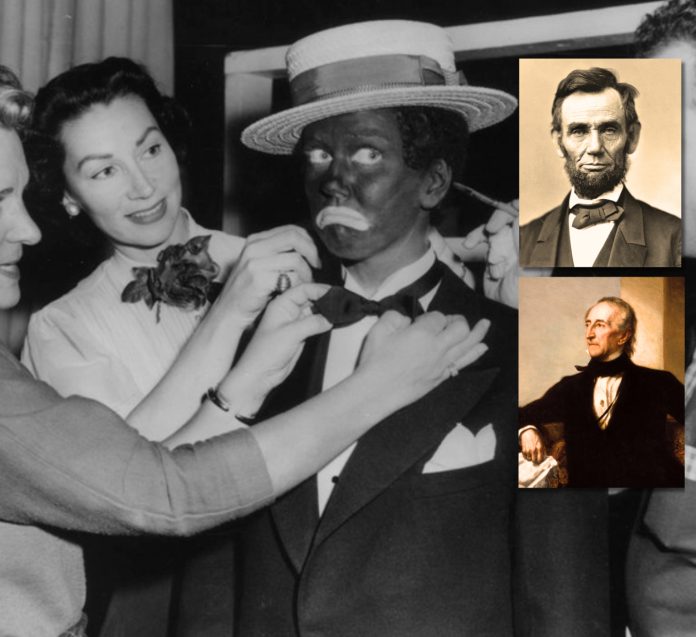White Skin in a Black Mask
Some historians love to live in the past without ever knowing the real past. Some historians live in an imaginary past, knowing the truth but refusing to discuss it. This is true of history of “Black-Face” as performed by minstrels. Accordingly, a minstrel was, “a member of a band of entertainers, typically white actors with blackened faces, who performed in a type of stage entertainment prevalent in the US in the 19th and early 20th centuries, featuring songs, dances, and comic routines using stereotypical depictions of African Americans.” These racist performances were designed to prove that Blacks were inferior and that they were incapable of intellectual thought. The performances in Black-Face were truly an indication of an inferior and ignorant mind. The minstrel stage became a form of White entertainment designed to reinforce the ideology of white supremacy.
“Black-faced” shows were preformed in the presence of presidents including John Tyler, and Abraham Lincoln. These shows were designed to divide people based on the false concept of “race.” Black-face shows delighted racist audiences and sought to raise the poorest white to a status just above someone with dark skin. It reinforced the idea that skin color was more important than the economic status or the class position of an individual. Black-faced performers also reinforced Jim Crow laws and attitudes and contributed to violence in the fact that the shows made the point that Black people were not human and could thus be brutalized. The message of Black-faced minstrels also included the idea that White lives mattered and Black lives did not. Whites could be Black but only for a little while—while propagandizing the audience.
The circus groups, mainly P.T. Barnum, used Black minstrels to make fun of Black people to brainwash young White children. Some Black-face shows had Whites singing “Carry Me Back to Ole Virginny,” or “I Wish I was in Dixie.” In this way, it was made to appear that Black people liked being slaves which was a racist lie. All of this was designed to push the idea of a “Southern Heritage” of white superiority and hatred while expanding slavery during the Civil War and Jim Crow Law afterwards. It was used to expand racism in United States from coast to coast with the genocide of Native People. The minstrels also used racist jokes during their performances. When the anti-slavery novel “Uncle Tom’s Cabin” was written, southern bigots used minstrel shows to make the Uncle Tom character in the novel the other Uncle Tom we now use to describe people like Tim Scott and Clarence Thomas. One song these racist sung was titled, “Happy Are We, Darkies So Gay.” Also, Black-Faced minstrels were used to destroy the Freedmen Bureau during Reconstruction and make the claim in entertainment that Black people were unfit to govern or given the vote.
Being proud of “whiteness” was made at the expense of Black people. It was hatred glorified and made funny. The Christy Minstrels were quite popular amongst racists and make appearances across the country with these white supremacist acts. The acts were aimed at the farce of Jacksonian Democracy which pretended to be a savior for the white working class at the expense of Blacks, Browns, and Native. After the Civil War, the acts appealed to the longings for a past based on the plantation dream of owning slaves and a big house. Even after Black-faced shows ended they used TV shows like “Amos and Andy, The Jeffersons, Good Times” and others that had Black characters acting like buffoons.






